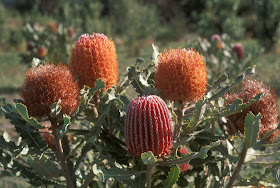Scientific Minds Want To Know
Biodiversification isn't always
favoured by living in a hotspot of biodiversity, suggests a study of
Australian wood shrubs. The finding, reported in the open access journal BMC Evolutionary Biology, goes against previous thinking and boosts our understanding of the factors driving biodiversity. |
| Proteaceae: Banksia menziesii [Credit: Dennis Stevenson] |
The group is found in many parts of Australia, including the biodiverse Southwest Botanical Province, which boasts more than 7300 plant species amidst shrubland and semi-arid heath, and Mediterranean-climate forests. But although Banksia species richness in this hotspot is ten times that of the rest of the continent, it's not diversifying any more quickly than Banksia plants in other parts of Australia.
The question then, is how the biodiversity of the Southwest Botanical Province arose. If new species aren't arising more rapidly, perhaps they die out less frequently compared with similar plants in biodiversity poor regions. Part of the answer, the team suspect, is that new species accumulate steadily in biodiversity hotspots, at unexceptional rates, generating botanical richness over long periods of time.
The team also looked at biodiversity within the confines of the Southwest Province where they found that Banksia plants in semi-arid heath and shrublands were diversifying more quickly than plants in the high-rainfall forests. Diversity is likely generated in these semi-arid regions, then migrates out to boost diversity in the adjacent forest. Comparing hotspots with non-hotspots therefore, may be an over-simplification. The geographic pattern of Banksia diversification is far more complex than this.
Biodiversity hotspots are frequently found in Mediterranean-climate regions, where they rival tropical rainforests for flowering plant biodiversity. But these environments typically lack features such as high rainfall or productivity that are usually linked with high plant diversity. Indeed, some of the most species-rich Mediterranean communities are found in semi-arid regions, on nutrient-poor soils. Understanding these apparent outliers on global biodiversity gradients may yield insights into the factors driving the diversification of flowering plants.

No comments:
Post a Comment